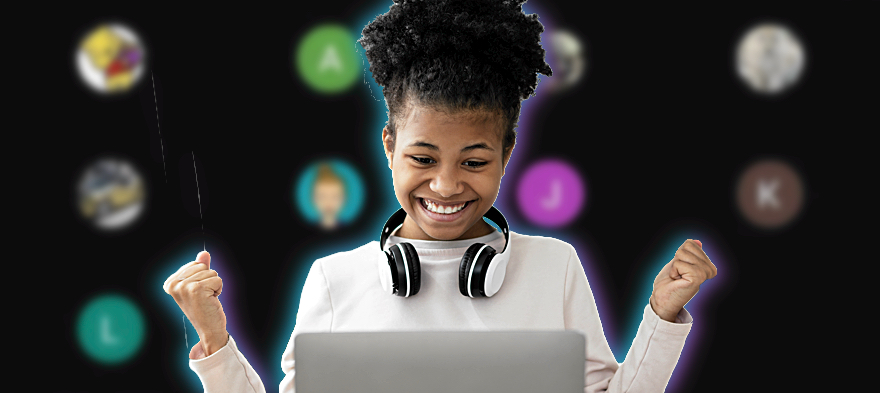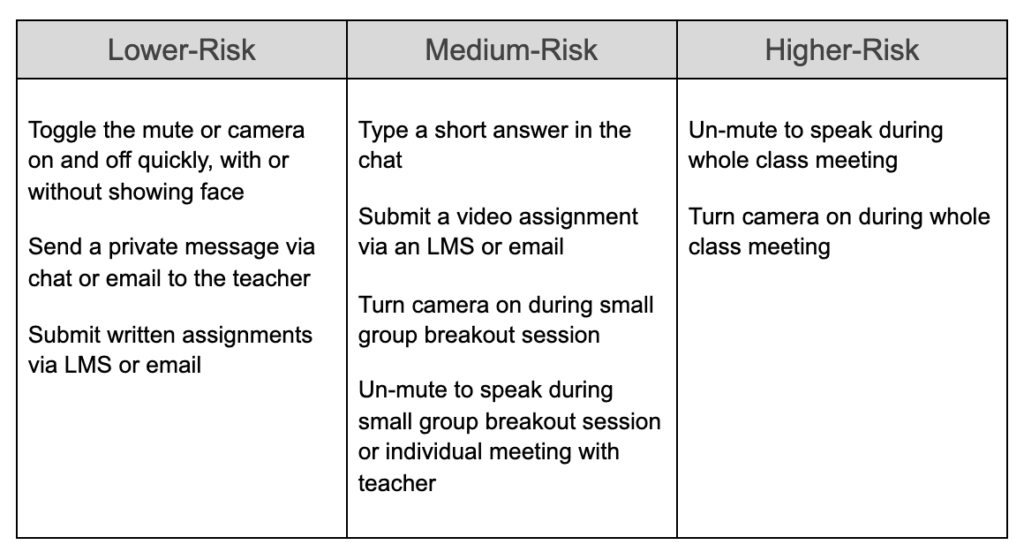
Mention cameras during distance learning and you’ll instantly evoke passion, stress, and even fear, in teachers and students alike. Last month, I listened as a high school senior shared his story with our school board, observing that all it would take would be for one of his peers to be brave enough to turn their camera on, and others would follow. But even he wouldn’t do it.
Soon after, I listened to a teacher I’ve known for years, who is normally peppy and positive, fall into tears in a meeting at the thought of posting videos of himself online, out of fear that his students would make fun of him or screenshot his picture to spread on social media.
And they are not alone. [pullquote] Teacher after teacher takes to Twitter to chronicle their rejection, isolation and frustration in response to the wall of blank screens that they face every day.[/pullquote] The issue extends to parents and higher ed, too. The cameras on/off debate kicked off hot in early spring and has shown no signs of improvement since virtual school started again this fall.
Some have mandated cameras on during class, hoping to encourage relationships, student engagement and attendance. However, this strategy is doomed to fail. Policing behavior like this can push students away instead of drawing them into the relationships we seek. There are many reasons students need the option to turn their camera off, including:
In my school district, nearly half of all students access the internet through school-provided hotspots with barely enough power to hold a live connection to video classes. Some of these are used by up to eight students in a household. Even more alarming, I learned recently of a local senior with a 3.86 GPA who is failing most of her classes (which end next week) due to unreliable internet and the need to care for four younger siblings at home during the day. [pullquote]Cameras only matter if the student has access to learning in the first place[/pullquote], and many of my students don’t even have that.
Considering these equity and social-emotional concerns, many educators have advocated for a hands-off stance to this issue. But this leaves teachers feeling even more alone during this challenging time. In a recent survey in my school district, isolation from students was the number one biggest challenge all educators identified this fall.
Students having their cameras perpetually off also adds to the barriers that teachers face in monitoring student progress and engagement during distance learning. Teachers worry that when kids do finally come back to school, they might walk straight by their own students in the hall for having never seen their face.
While this issue feels deeply personal, perhaps the solution requires a step back. [pullquote position="right"]What strategies can educators recall from the Pre-COVID era, practices that we know will nudge students toward the behaviors we hope to see?[/pullquote] When I reflect on my own classroom, I depend on two strategies to lay the foundation for positive relationships:
In a virtual setting, we can give students ownership over class norms about cameras on/off. This can help students build trust with each other, reduce anxiety about turning on their cameras, and give them space to discuss their personal “why” for having the camera off at times.
In her Mindset Mathematics books, Dr. Jo Boaler shares an excellent protocol to prepare students to take risks together. In this protocol, students articulate how they do and don’t like to be treated by their classmates and the teacher while they’re engaging in (insert risky-feeling-activity here). The norms are made by starting with small group discussions and moving toward a whole class consensus. Giving this structured space for students to openly name their concerns builds accountability and buy-in to the resulting expectations.
I created this template to implement this strategy with students in multi-age groups from grades K-5. Each time I’ve facilitated this process, the conversations have been authentic, vulnerable and ongoing. We review the norms throughout the year, discussing the class’s strengths and areas for improvement. Because the norms are student-created, they own them and norms-check each other to keep our class on track.
For students who are shy or anxious about being on camera, we can help them build confidence by easing into activities that feel risky, like turning on their cameras. Consider providing differentiated options for engagement or balancing the risks you are asking students to take during the lesson.
If the discussion, assignment, or activity presents a high cognitive load, give students a less-risky option for engagement. If you want students to participate in a way that feels out of their comfort zone, start with a very low-risk activity. Games like “Would you rather?” or “Have you ever…?” are great for this!
I’ve seen teachers ask students to quickly flash their mute or camera on and off to show agreement, sometimes not even showing their face on the screen. It breaks the ice and sets a foundation for another step forward in participation.
Here are some examples of differentiated participation styles in distance learning:

Camera use during online classes will always be fraught with emotion. Some of the challenges, like environmental distractions and access to reliable internet, are outside of our immediate control. However we can immediately help students build confidence in themselves and trust with us and each other. This, remember, is who we are. It’s what we do. Sometimes it feels like everything we know has turned upside down this year, but it hasn’t! Let’s step back, rely on what we know and adapt it to fit the current situation. Let’s teach.
Camille Jones is an instructional technology coach in Central Washington State, and the 2017 Washington State Teacher of the Year. Prior to COVID-19, she spent 10 years teaching elementary students. For her classroom focus on nurturing the strengths and talents of all students, Bill Gates named Camille one of his 2017 "Heroes in the Field."
If you have a child with disabilities, you’re not alone: According to the latest data, over 7 million American schoolchildren — 14% of all students ages 3-21 — are classified as eligible for special...
The fight for educational equity has never been just about schools. The real North Star for this work is providing opportunities for each child to thrive into adulthood. This means that our advocacy...
The story you tell yourself about your own math ability tends to become true. This isn’t some Oprah aphorism about attracting what you want from the universe. Well, I guess it kind of is, but...
Your donations support the voices who challenge decision makers to provide the learning opportunities all children need to thrive.
Ed Post is the flagship website platform of brightbeam, a 501(c3) network of education activists and influencers demanding a better education and a brighter future for every child.
© 2020–2024 brightbeam. All rights reserved.